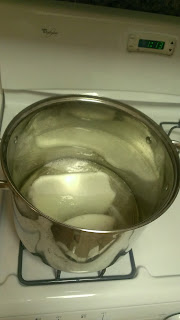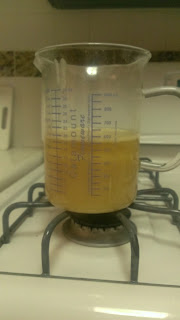In which I make two rookie mistakes thus creating unwanted excitement in my kitchen.
I decided to do another tallow rendering for two reasons: First I wanted to take a try at making hand sanitizer now that I have ethanol available, and second because the soaps went over pretty well with F&F.
What goes in
I went to a large local supermarket, rang the butcher's bell, and I asked if he had done any trimming today. When he said he had, I asked if I could get "a couple pounds" of the trimmings. He was happy to oblige, presumably because it was a slow Saturday morning.
I came home and measured it out: precisely 1400g of trimmings, but as you can see from the picture, a rather a high percentage was meat so I'm not sure what the end yield will be.
Getting started
I put the fat in a stewpot with a liter or two of water and turned the gas jet up to medium-high.
You
can render fat with no water. It is definitely more efficient: the water's going to boil away or be discarded eventually, and there's no reason to waste the energy turning a liter of liquid water into water vapor. Likewise, it's slightly safer since it's impossible to have a bubble of water pop up through a layer of rendered fat and spatter it everywhere.
I use water because it lets me work directly with big chunks of fat without having to cut them up or grind them, and without spending a lot of time tending the pot at the beginning to make sure the fat melts without burning. By the time the water's boiled away, there's enough liquid fat in the pot to conduct heat to the rest of the contents. It's fire-and-forget.
The smell of rendering
Every time I've done this, I get the smells of cooking food: sizzling bacon mixed with a little stewbeef. Despite this I have heard, over and over, that the smell of rendering is bad. This is one of those things that "everyone knows", it seems. I do open the window and turn on the fan, but it's to get rid of the steam. So either what "everyone knows" is dead wrong, or I've been extremely lucky with the materials I've had to render.
Can someone else who does this please relate your experience? I'd really like to know where this belief comes from.
Rendering
By the 30 minute mark, the liquid bubbling in the pot is dark, more viscous, and spits if you drip a drop of water into it.
At the 0:45 mark, there is clearly no water left in the bottom of the pot. There is a large amount of liquid fat, with the larger pieces floating in it. I checked to make sure nothing was stuck to the bottom, and that the floating bits still included fat that had not liquified. Then I turned the gas down to just over "low": enough to keep the fat bubbling and continue the process.
At the 1:10 mark, it was done. There were huge clumps of solids still floating, but when I fished a couple out and cut them in half, they were all protein. I took the pot off the stove and turned off the gas jet. Later measurement showed 220g of deep-friend protein. Too bad I don't have a dog.
Tip #1: If you have just strained 220g of protein solids out of a pool of hot oil, when setting them aside, do not set them on a styrofoam butcher's tray. Melted styrofoam is neither an attractive nor pleasantly fragrant addition to your kitchen space. -Ed
The liquid tallow
I poured the whole lot through a spaghetti strainer to remove the chunks and got the (relatively) pure fat into a different pot. I waited until water dripped in did NOT spit, then tossed in enough warm water to form a short layer underneath the tallow. Then I stirred the pot to bring the water into contact with the oil and its contents.
The layer of water gives the carbonized bits and chunks still in the tallow somewhere else to be. Most of them are heavier than water, so they fall out of the tallow and into the water. Likewise curing salts or other material from the meat tend to prefer the water to the fat.
I set it aside and let it cool down on the cooktop, then put it in the fridge.
The initial results
Once the tallow had hardened in the fridge, I weighed it. I had 780g of very soft tallow. I'm not kidding, the results tallied exactly 1kg to the gram. The tallow was so soft because the source had included a lot of soft, low melting point beef fat. It was also somewhat brownish, apparently from stuff that had made it through the strainer or that hadn't left the fat for the water.
A little math, for the sake of science: 1400g in, 1000g out, 400g LOI. I assume it's almost all in water lost as steam, because the amount that could have been lost as fryer smoke would be fractional grams at most.
I elected to try and get it to a pure white before proceeding, so I decided to reboil it and filter it more completely through a finer seive, and then through a paper filter.
Second boil
You know, I
knew there was a reason I hadn't used water in the second boil the first time I made tallow. I ended up with a mini-BLEVE that blew the lid off the boiler and covered a substantial fraction of my kitchen counters and floor in a fine coating of liquid tallow. Eeew.
I *do* have a chemical rated fire extinguisher, but happily it was not needed.
Tip
#2: If you are going to boil water under oil, do it at a rolling boil,
like when you make spaghetti and put a little oil on the top. Or don't
boil water under oil at all. Or if you do, be prepared to handle surprises. -Ed
After-incident report
In retrospect, the problem was obvious, and the payoff is some practical experience with some fairly cool physics:
The water is essentially in a sealed container: the bottom and sides are the pot, and the "lid" is a coating of oil. The oil "lid" acts something like a blanket: absorbing some heat while reflecting another fraction back into the water. Since the water is in direct contact with the bottom, which is in direct contact with the flame, the water gets hotter much faster than the oil.
There is also a slight pressure exerted on the water due to the weight of the oil. This means that when a substantial bubble of water vapor finally forms and rises through the oil, the oil is pushed away from the part where the bubble comes through, removing the weight of the oil and suddenly creating an area of low pressure in the water. The lower pressure lowers the boiling point of the water underneath, which causes more of the water to suddenly convert to vapor, causing more holes in the oil, causing lower pressure, and each cycle speeds the next. This is not a true BLEVE, because nothing is exploding, but the forces at work are pretty much the same.
In short, it tends to go from a quiet pot to a fountain of oil blowing the lid off your pot in a very small fraction of a second, probably leading to excitement and cleanup projects you might wish you didn't have.
As always, Caveat Scisor.
Things I learned
- When doing a purifying boil on tallow, skip the water
- The screen on a Samsung Galaxy Note 3 is liquid-tallow-proof
- Even though it wasn't used, I'm really glad I have a good fire extinguisher
Conclusion
After the cleanup, I came to the conclusion that there wasn't enough tallow to continue the experiment, so I disposed of the remainder of the tallow and started again at the top.
If the weather continues bad tomorrow, I'll probably go back to the market and begin Tallow #3.











